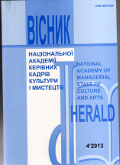Entertainment television: historiography of the scientific problem
DOI:
https://doi.org/10.32461/2226-3209.4.2013.138039Keywords:
culture, television culture, television, television sphere, media entertainment, entertainment paradigm, entertainment television, entertainment program, showAbstract
An intensive expansion of television as a mass oriented art form has been a characteristic tendency in media culture evolution in Ukraine over the recent decades. Its social value lies in the unlimited audio and video informational capacity. Factual and close to actuality as it is, television allows for wide capabilities of selection and interpretation of reality. By synthesizing the genre related features of cinema, variety show, literature and music, television increasingly implement its potential as a mass communication medium. An important part within the poly-functional complex of modern television, including that of Ukraine, is the implementation of mass entertainment function. Naturally, the latter has been of an interest for scholars of wide range, such as cultural scientists, art critics, philosophers, psychologists, modern mass media theoreticians and practitioners. Particular aspects of modern culture and art are reflected in specialized articles, studies and dissertation researches. The phenomenon of television is definitely a significant element of moral culture in a globalized modern world. This poly-functional network answers the mass viewer needs in information due to the absoluteness of representation. Television is virtually capable of making the viewer think within the categories of a definite nation or humanity on the whole as well as, to certain extant, affecting the ethics on the global scale by implantation of natural positive visual images. With the potential of the genres inherent to television such as TV play, TV movie, interviews with prominent culture and art personalities it contributes to formation of the artistic and aesthetic tastes of mass audience. Cultural entertainment television content is undoubtedly significant for the recovery process as an individual’s mental powers are consumed during working and professional activity. By entertainment content is considered that containing elements of competition, humor, game and escapism combined psychologically and by screenplay resulting in the audience’s emotional reaction that ultimately leads to aesthetic pleasure and healthy relaxation. Television entertainment culture is genetically rooted in the people’s pastime stereotypes, in history of Ukrainian folk show culture such are traditional Ukrainian evening parties "vechornytsi". As an important phase in evolution of show and entertainment art the emergence and expansion of the cities should be viewed upon. It’s in the city that contrasts between work and pastime, group and personality, freedom and constraint came out dramatically. Compared to rather monotonous, poor of impressions country life the city environment became a kind of physiological compensation mechanism accompanied with the myth of "eternal feast", permanent entertainment. The first attempt in the European science to comprehend the artistic and aesthetic significance of the entertainment show in connection with mass anti-clerical activities during French Revolution is considered to be the reflections of the French Enlightenment philosopher Jean-Jacques Rousseau. It should be noted, that Enlightenment philosophers referred principally to the theater, in their minds mainly associated with the show. Those fundamentally new forms of ceremonial culture, being a veridical reflection of the surrounding world, were meant to glorify the moral merits of the nation as a history subject. The tendency of viewing the theater as a main show act can be traced in later scientific researches. The declaration of state independence made it a matter of necessity for Ukraine to form the country’s own television sphere as well as its program content. In course of privatization of the television and media sphere a number of non-state (commercial) TV broadcasting and TV production companies was established, entertainment content being a significant part of their activity. In modern conditions a fast technical upgrade of domestic television facilities takes place together with own production and adaptation of foreign experience in entertainment television culture. The study of the modern television cultural entertainment paradigm takes following directions: the works on history and current situation in television culture, media entertainment features (E.Kurova, O.Kosyuk, M. Maloshyk, T.Reva, N.Tchetchel, S.Shaumyan and others); the works exposing the influence the entertainment television content has upon youth audience (by O. by O.Kasatkin, T.Kiselyova, G.Kondratenko, O.Nevmerjitska and others); the works analyzing the nature of the game as a essential element of entertainment content (D.Buklans, S. Zukov and others). The process of creating youth oriented entertainment content and its functioning is described in the works by M.Burmaka and O.Kasatkin. Undoubtedly, the study of domestic television entertainment content further development will remain relevant and of practical usage.Downloads
Published
Issue
Section
License
Authors who publish with this journal agree to the following terms:
1. Authors retain copyright and grant the journal right of first publication with the work simultaneously licensed under a Creative Commons Attribution License International CC-BY that allows others to share the work with an acknowledgement of the work's authorship and initial publication in this journal.
2. Authors are able to enter into separate, additional contractual arrangements for the non-exclusive distribution of the journal's published version of the work (e.g., post it to an institutional repository or publish it in a book), with an acknowledgement of its initial publication in this journal.
3. Authors are permitted and encouraged to post their work online (e.g., in institutional repositories or on their website) prior to and during the submission process, as it can lead to productive exchanges, as well as earlier and greater citation of published work (See The Effect of Open Access).


